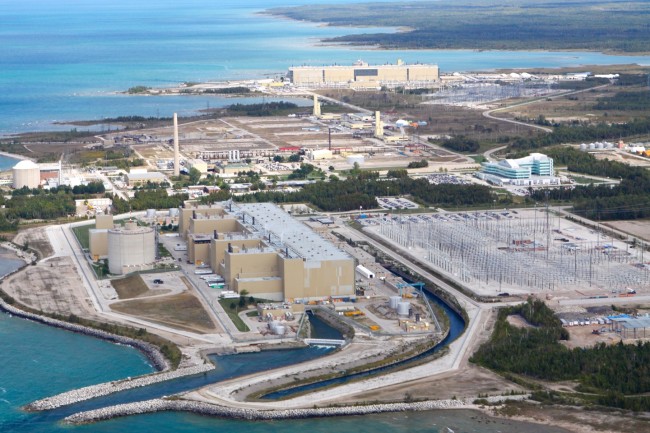
OPG sticking to its guns on Lake Huron nuclear waste storage site
by John Flesher, The Associated Press

OPG's Lake Huron plan is controversial: 186 cities, counties and other governments have passed resolutions against the project and 150,000 people have signed petitions in opposition

The Bruce Power Station in Tiverton, Ont. is the preferred location for underground nuclear waste storage. PHOTO: Bruce Power
The power company, a Crown Corporation majority-owned by the Ontario government, has submitted additional studies ordered nearly a year ago by the Canadian Ministry of Environment and Climate Change, which twice has delayed a ruling on the company’s underground disposal plan. The agency said recently it expects to make a decision this summer or fall.
The company’s preferred site is on the grounds of the Bruce Power Generating Station near Kincardine, Ont., the world’s largest nuclear power complex with eight reactors.
The proposal calls for burying low- and intermediate-level waste such as clothing, brooms and discarded machinery—some of which could remain dangerously toxic for thousands of years—about 2,230 feet underground.
It would be encased in a limestone formation that the company says has been stable for 450 million years. The storage chamber would be much deeper than Lake Huron and the company says there is virtually no chance of radioactive pollution reaching the lake, which is less than a mile away.
Responding to a request by Environment Minister Catherine McKenna, Ontario Power Generation said it had examined two alternative sites—one in a crystalline rock formation in north-central Ontario and the other in limestone in the province’s south.
The specific locations were not disclosed because of the study’s hypothetical nature, company spokesman Kevin Powers said, adding that both are farther from the lake than the Bruce Power site.
Although technically and economically suitable, they would be costlier and could affect the environment more than the preferred spot, the report said. Building a disposal facility at either of the alternative sites would create a new industrial footprint and boost greenhouse gas emissions for decades as waste is hauled from temporary storage canisters at Bruce Power to the permanent dump.
“And all for no assurance of greater safety to the environment or to the lake,” Powers said.
Opponents of the Bruce Power disposal plan remained unconvinced.
“Surely in the vast land mass that comprises Canada, there must be a better place to permanently store nuclear waste than on the shores of Lake Huron,” said U.S. Rep. Dan Kildee, a Democrat from Michigan.
A review panel appointed by the Canadian government endorsed the project in 2015 after lengthy hearings that included testimony and reports from scientists.
But 186 cities, counties and other governments have passed resolutions and more than 150,000 people have signed petitions in opposition, according to a Canada-based group called Stop the Great Lakes Nuclear Dump.
“Water is Life,” said Beverly Fernandez, the group’s spokeswoman. “No matter what process is followed, burying radioactive waste beside the Great Lakes, the irreplaceable drinking water for 40 million people, will always be a bad idea.”